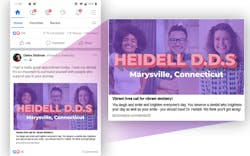How to boost digital word of mouth without gimmicks, and with a share card
By Rick Pearson
Have you ever wondered what you can do to gain more mentions on social media and experience digital word of mouth?
What you’re doing right
You’re handing out referral cards. You’re following up appointments with referral reminders. You might be incentivizing recommendations, reviews, and online mentions. Your service is second to none. Your facilities are state-of-the-art. Your staff are the warmest, friendliest, and most helpful people.
Yet even if you’re doing all of this, you notice that not even your most fervent superfans are talking about you on social media. What more could you possibly be doing?
Brace yourself. You’re about to find out why your social shares on Facebook and Twitter are much lower than you want them to be.
Where things are falling apart
You’ve built your practice, filled out a list of services worth talking about, and asked people to talk about you. Your strategy is good, but it’s the last piece of the puzzle that you’re not putting into place.
Imagine building the road you want patients to travel for you, but not paving it for them. You can point to it and tell them that the road exists, but people aren’t going to drive on it. At least not nearly as many people as you would like. It is, after all, a bumpy experience.
So, how do you pave this road? What is the final puzzle piece for social sharing that you aren’t putting into place? It’s actually very simple. It’s a social share card.
A share card is often the first impression you make on prospective patients. To explain the importance of your social share card, you must consider one thing. You need to understand the total sum value behind word-of-mouth advertising, and what it means for everyone involved.
Word of mouth is a two-sided transaction. You’re only seeing half of the picture
You know what word of mouth advertising means for you, the private practice owner. It's credible, free advertising. There’s no more credible form of advertising than peer-to-peer. Patients listen to other patients. They trust each other more than they trust you. We know this.
But what if you’re seeing only half of the picture? What if it's the unseen side that’s hindering your social referral acquisition? Have you ever asked yourself what it means for a patient to provide you with word-of-mouth advertising?
The psychology behind word-of-mouth
Word of mouth has nothing to do with you or your practice. It’s 100% about the person who’s doing the sharing. When a patient shares your practice with others online, it’s about them. They aren’t trying to boost your reputation or help you out. The effort they’re investing is in boosting their own reputation.
We all carefully curate what we share in our newsfeeds, tweets, and posts. This choosiness extends to which businesses we recommend. It is a truth that everyone, consciously or otherwise, is sensitive to. To understand why this is true, we need to discuss a few things.
People share things with their spheres of influence for two reasons—resource sharing and vanity. Some people use posts to build or reinforce how they want others to see them. Others share for the more altruistic purpose of sharing a resource. Almost everyone belongs to both groups. Most social posts serve both functions.
Time-honored word of mouth faces a modern problem
Before the internet, it was less risky for someone to put their neck on the line for a business via word of mouth. Perceptually, passing along a glowing review for a practice didn't carry much consequence. The only way to factcheck a recommendation was to experience a service for yourself.
If a recommendation panned out, great. If it didn't turn out so well, no big harm because recommendations went to one person at a time. There was no risk of being perceived as having poor judgement or low standards by a big group at once.
Today, recommendations appear to entire social circles. Adding to the stakes is that judgement on the validity of the recommendation is instant. It’s a judgement based more upon perception than actual quality of service. In this context, the share card offers a first and often lasting impression. Your prospects need you to prove yourself to them online, at a glance. If your share card is ugly, people will keep it out of their feeds. They don't like the way your share card reflects on them.
They do like your business, but they don't like the way your business looks in their feeds. If people remove the visual aspect of your post, it means they may rethink the post entirely. This means diminished or no return for your digital word of mouth.
Your website is the command center from which the visuals are sourced for your share card. You can choose to display a unique visual card for each platform. This is an ideal step if you are using each platform for specific outreach and presence. You can also tell your website to send out the same preview card to all social platforms uniformly. The only important rule of note is to put your best foot forward.
Checklist to help you ensure an effective social share card
1. It should resonate for your ideal patient persona.
2. It should represent your brand by displaying the personality of your practice.
3. It should reinforce the public image that your ideal patient wishes to project to others!
Your governing philosophy should be, Make your patients look good in their social circles. When you do, they'll use this to their advantage at every opportunity. And that is good for your business.
Conclusion
Brand affiliations reflect on personal stature. This is true for your patients, who are creatures of vanity. That which we promote in public reflects back on us. Credibility is as much perceptual as it is actual. When your public image inspires confidence, it requires no thought when it comes to sharing with others. You create a scenario in which patients assume no risk in sharing word of your practice. Those who see you appear in their friends’ newsfeeds will perceive you as worth a look. As a result, you will likely see your successful social share rate experience a healthy increase.
Rick Pearson is a communication strategist and website developer. He specializes in dental website designs for private practices. Pearson aligns his work to the goals of connecting meaningfully with prospective audiences. See more of his insights or learn more about his work at abmonetize.com.


